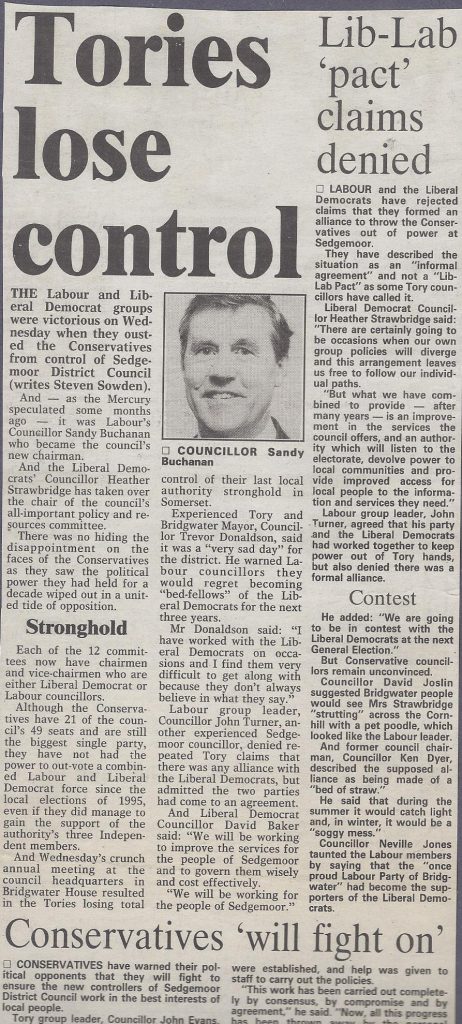
When Sedgemoor District Council was created in 1974 it destroyed not only 500 years of Bridgwater history by ending the town’s Borough status, it removed a strong and popular Labour council in this working class town and replaced it with decades of one party right wing Tory rule by a fixed majority of Conservative councillors from outside the town. But then in 1995 the unthinkable happened and the Tories were booted out. How did this happen? What happened next? And could it happen again? Present Town Council Labour Leader Brian Smedley was part of that 1995 administration and tells the story. From his own totally biased perspective.
It may just come to you occasionally in a dream but Sedgemoor hasn’t always been Tory. In 1995, after 18 long years of truly awful Tory rule, they were starting to collapse. I’d been elected to Sedgemoor in a 1990 by-election at the height of the Poll Tax rebellion which Bridgwater was at the forefront of with our popular Anti-Poll Tax Union organising an occupation of the council chamber on the day of my election, maintaining a permanent presence at court cases to help those being persecuted for non-payment of the unfair and impossible to pay tax and holding Bailliff watches on the towns estates to prevent seizures of people’s property. Thatcher was forced to resign to save the Tory party from wipe out that year and then in 1991 Labour grabbed a further 8 seats at the District elections including by other members of the anti-poll tax union.
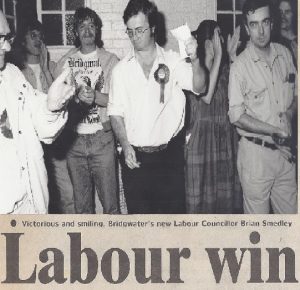
Fightback after Years of Oppressive Tory Rule
In 1991 Labour gained 584 district seats across the country and over took the Tories in the popular vote with 38% to their 35%. However, at the same time, the LibDems were also on the rise due to the so called ‘Ashdown factor’ – quite big here in Somerset where he was Yeovil MP and they took 22% of the National vote.
The ‘Ashdown effect’ was a double edged sword as it encouraged some Labour voters to think that they had to vote ‘tactically’ when probably they could have totally ignored the Liberals and simply voted Labour as Tory popularity was plummeting anyway . By 1993 however, the Lib Dems had gained Somerset County Council from the Cons -and this was one of only 3 Libdem councils in country . However, it meant the Tories were sweating in places they never expected to sweat. Their own back yard. The Tory shires. Nationally Labour was up to 39% the Cons down to 31% and the Libs up to 25% . The Blues lost 486 seats.
Tories on the Ropes
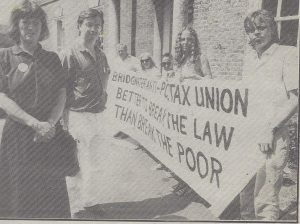
So by 1995 the Tories were on the ropes –but people were just confused about how to get ride of them and so the vote was split. Tony Blair had just become Labour leader. For some he was a youthful symbol of change, but to many he was just a box of soap powder and begrudgingly a stepping stone on the way to socialism . In fact Labour would have gained in the polls anyway, so when the 1995 District elections came along and the Cons lost 2000 councillors, Labour actually won 48% of the vote-a record high in local elections. Many of us saw it really as the legacy of John Smith and the years of anger at the Tories finally bearing fruit. And of course the ‘SDP’ (who had kept the Tories in power by splitting the Labour vote in the 80s’) were finished. With Labour nationally on 47% gaining unlikely councils such as Hove, Thanet and Lichfield, the Cons dropping to 25% and even the Lib Dems falling slightly to 23% all eyes were on Sedgemoor.
Sedgemoor had been Tory since 1974-although in the first few years they relied on Independents (inevitably right wingers) but in 1995 it fell to No Overall Control along with other regional authorities such as North Somerset ,South Gloucestershire, Bath and West Somerset. Mendip was already and stayed NOC, while South Somerset and Taunton Deane already were Lib Dem and stayed that way.
The 1995 Election
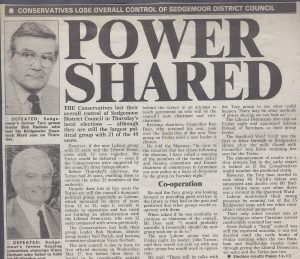
In Sedgemoor the Tories lost just 5 seats, but the Lib Dems gained 5 and Labour gained 1 . In the haze of ‘tactical voting’ the Libs had confusingly also taken from Labour (in Highbridge) and so the majority was knife-edge.
As the count wore on some big names started to go down . Con leader Bob Hudson lost his seat in Bridgwater Quantock ward and then his Deputy Neil Parish (nowadays a Tory MP) lost his Pawlett and Puriton seat to Lib Dem newcomer Heather Strawbridge.
Tension rose with a recount in Tory Quantock ward and for the first time in history Labour took a seat there with excitable Scot Bill Munn grabbing the seat. His wild whoops of enjoyment echoed through the Labour club on hearing the news of the recount and slim victory (I know because I was sat next to him).
In the cold light of day we looked at the results and saw the Tories had slumped to 21 seats and even with the 3 rightist independents they couldn’t equal a combined Labour(13) and Lib Dem(12) tally of 25. But to ensure this, we had to take control of the Chairman’s casting vote.
Labour was clear. We would grab the chairs from the Tories and seize control (as they fell crashing to the floor . chairless and on their arses).
The first meeting of the new council was Wednesday May 17 1995. Interim Tory leader Ken Dyer had called an emergency meeting of his group ‘in view of the situation that has arisen…’. All their nightmares of losing control were about to come true.
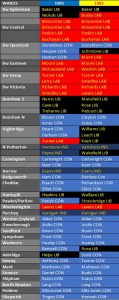
The Lib Dems also held a private meeting, but they had problems. Absolutely no experience and they were wary about taking responsibility. What would they do? Never a good question to get a straight answer to from a Liberal.
Their leader, Burnham councillor Alan Petoud, decided to go on holiday to Portugal and so missed the crucial meeting. The Lib Dem Deputy Leader was David Baker, former SDP man and who , some years later, would re-emerge as a Tory
So at the meeting it was crucial as to who would first be elected as Chair of Council, because that person would have a casting vote. Labour put up popular Bridgwater Central ward councillor Sandy Buchanan and the Tories put up Farmer Dyer. It was up to the Lib Dems. They abstained.
Dyer won the vote with 22 to Buchanan’s 14
Labour Leader John Turner described ‘an act of incredible ineptitude by the Lib Dems’.
The Labour plan to take committee chairs from the Tories and allocate them between Labour and Libdems was now unlikely to pass. Baker and co now tried to make up for their mistake and back the Labour motion but found that the Tory Chair they had just let in by their abstention used his casting vote against. And then…..they backed the Tory proposal for a 3-way power share instead. The Tories had clung on.
A wasted year of Liberal indecision
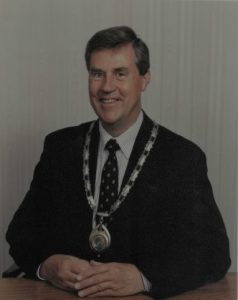
It would take one more wasted year, until the annual meeting of 1996, for the Lib Dems to vote the right way and not go on holiday. In May 1996 Sandy Buchanan was voted in as the first Labour Chairman of Sedgemoor and Lib Dem Heather Strawbridge became Chair of the influential Policy and Finance committee therefore the Lib-Lab groups could vote through their policy by Chairs casting votes.
Even the outgoing Conservative Mayor of Bridgwater Trevor Donaldson made one final barbed comment saying “Lib Dems are difficult to get on with as they don’t always believe in what they say themselves”
While Tories attempted to define the new power sharing in Sedgemoor as a ‘Pact’ both Libdems and Labour denied it preferring to call it an ‘informal agreement’
Heather Strawbridge said “We have combined to provide-after many years-an improvement in the services the council offers, listen to community and devolve power and improve access and information for people”
John Turner , Labour group leader denied any ‘pact’ and said “We will be in contest with the Lib Dems at the next election, you mark my word” as he took the seat he’d always wanted as Chair of Housing.
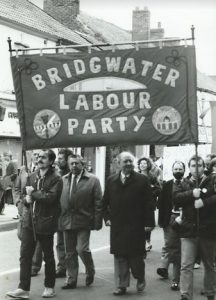
The Tories were apoplectic as their hands were firmly pushed off the reigns of power with Cllr David Joslin (who had publicly labelled me a ‘Parasite’ during the Poll Tax campaign) saying “We will soon see Mrs Strawbridge strutting across the Cornhill with John Turner as her pet poodle”
But John Turner was no-ones poodle and for the next 3 years Housing was one of the areas that the Labour dominated Sedgemoor made great leaps forward in, setting up neighbourhood offices in Hamp and Highbridge with plans for expansion and devolution around the district. It was also in Hamp, where I was the councillor alongside John Turner, that we made further advances, setting up a Hamp Youth Forum, directing funding into the estate and creating the Hamp Community Association as the focus for all future funding and services.
A Progressive Council
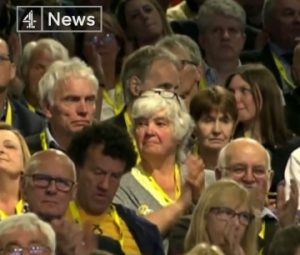
Personally, my specialist area was leisure, arts and culture and working with my new best friend Lib Dem Councillor Marilyn Wallace as Chair and Vice Chair of the Leisure and Tourism Committee, we not only helped keep the Bridgwater Arts Centre alive , taking the previously Tory dominated places on their committee, but we also set up an Arts Steering Group which introduced a’ % for art’ in any new development, expanded our international relations, fronting a business mission to Prague, which came back with 6 contracts, and (my favourite) set up the Sedgemoor Contemporary Music Group, which gave money and organisation directly to the Bridgwater rock music scene which went on to organise a host of venues for creative and original local musicians, brought out a series of CDs by over 30 local bands and undertook annual European music tours.
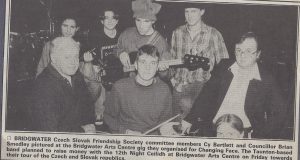
The new Non-Tory Sedgemoor also focused on Young people and set up a Youth committee. We also concentrated on the communities around Sedgemoor managing to maintain 3 swimming pools including the popular Sedgemoor Splash, which the Tories were later to close.
Never trust an ‘Independent’
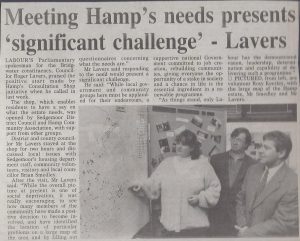
In the 1997 general election Labour won by a landslide taking 43%, the Cons 30% and the LibDems crashing down to 16%. The Tories were down 10% and the swing was to Labour . What’s more, the Tories were becoming divided over the European union, with Ken Clarke describing Michael Howards view on Europe as ‘paranoid and xenophobic nonsense’. There was a desire for change after 18 years of conservative rule – big names like Portillo ,Lamont and Mellor all fell alongside the disgraced (and currently ukip) Neil Hamilton.
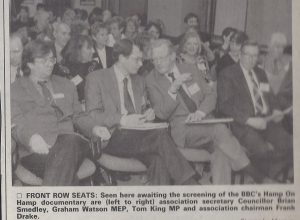
The Tories were desperate to regain control and gradually so called ‘independents’ were lured over to the Blue side of the room. But Labour was on a roll and in the 1999 Sedgemoor election increased seats on Sedgemoor up to 16, the highest ever.
Can History repeat itself?
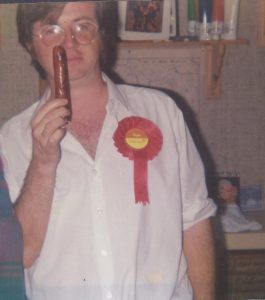
In 1999 the Lib Dems were wiped out. Crashing down to just 1 seat. The Ashdown effect had worn off and the Tories had desperately fought back against the Orcs and Hobbits in the Shires. The reasons were clear. Both Labour and Tories have a clear political position and a strong base in their respective communities while the Lib Dems don’t and are therefore totally vulnerable to time, mood and circumstances. They benefit from protest votes but when they get in power they blow it. And they never learn. Labour was in Government from 1997 until 2010 and did a lot of good restoring education funding, reviving the health service and rebuilding family and community support networks. In 1997 we thought we’d never see a Tory Government again. But it was the Lib Dems who let the Tories back in with their 2010 coalition. Which let in Cameron, which let in May, which let in Farage.
But in May 1995 history showed that it was there for the repeating of. A long harsh period of Tory rule, the desperate desire for change by a hard pushed population and the solution was there for the taking. Vote Labour. And just Labour. And everywhere.
